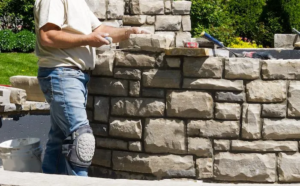Greensboro Hardscapes are non-living elements that add beauty and value to your commercial landscape. They also help protect the organic parts of your property from erosion, sun damage and other environmental issues.

Patios, decks, gazebos, outdoor kitchens, stone fire pits, and water features are all considered hardscapes. These features add texture, depth and visual diversity to your landscape and create spaces for entertaining.
One of the most important aspects of a home is its curb appeal, which refers to the way your house looks from a brief passing glance. It is the first impression a person has of your property and can either entice them to inquire further or discourage them from looking at your home at all. A home with beautiful curb appeal is a reflection of how well-cared for it is inside, while an unattractive exterior can be an indication of underlying problems that may require costly repairs.
In addition to adding value to your property, a curb-worthy exterior can make you feel proud of your home every time you walk up to it or invite guests over. This sense of pride is enhanced by compliments from neighbors or friends that mention how great your home’s exterior looks. It can also be a major selling point when it comes to listing your home in the real estate market.
While a lot of elements can contribute to a home’s curb appeal, the most significant factor is the condition and upkeep of the exterior. This includes the colors of the house, landscaping, walkways, and driveway. A clean and tidy front yard is always a good idea, while an attractively landscaped garden or flower beds can add a splash of color and charm to the home’s appearance.
Another key aspect of a home’s curb appeal is the entranceway, which includes the door, doormat, and other details that greet visitors as they approach. Adding a fresh coat of paint to the door and replacing a worn doormat are relatively inexpensive projects that can have a big impact on your home’s curb appeal. Similarly, a simple addition like a new mailbox can be an eye-catching focal point and help you make a statement as soon as you arrive at your home.
Adding an accent to the entryway, such as a wrought iron lantern-style light fixture, can create a warm welcome and complement your home’s color scheme. Other low-cost ways to boost your home’s curb appeal include adding a decorative urn or planter to the front yard and installing matching garden benches or porch swings. Finally, a well-placed trellis or arbor can provide structure to a landscape while providing visual interest at the front of your home.
Outdoor Living Space
A well-designed outdoor living space will add a unique visual to your home. Whether you choose to create an elegant deck or garden patio, or a full-blown sunroom, these types of projects can give your home a standout aesthetic that will catch the eye of anyone who visits.
Outdoor living spaces also provide an opportunity to create a relaxing environment for you and your family. They can be geared toward activities like grilling, entertaining or simply reading. Depending on the climate in your area, you may want to consider shade solutions or even an air conditioning unit.
When planning an outdoor living space, the first step is to determine what you would like it to be used for. This will help guide the design process and dictate what materials are needed to ensure functionality. For example, if you plan to entertain guests, you may want to include a dining table and seating area for alfresco meals. On the other hand, if you intend to relax and unwind, a lounge area with comfortable furniture might be a better fit.
Another important aspect of an outdoor living space is the amount of sunlight and shade it receives. This is particularly important in hot climates, where shade can be a critical factor to prevent overheating. In addition to this, a good amount of sunlight is beneficial for vitamin D intake and for helping reduce stress levels.
Adding a water feature to your outdoor living space is an excellent way to enhance the beauty and add a soothing sound to the environment. These can range from small store-bought fountains to a cascading waterfall. If you’re working with a budget, opt for a small fountain or a beautiful sculpture to add a pop of color and style to your outdoor area.
An outdoor living space is a great way to improve your home’s curb appeal and make it more functional. However, before you start on a project, it’s important to consult with an experienced professional. Contact Puget Construction and Landscape today to learn more about how we can upgrade your home’s exterior and boost its value in the process.
Outdoor Lighting
The right outdoor lighting can make the difference between a stark and ineffective home exterior and one that looks polished and elegant. Whether used to highlight key features like landscaping or architectural details, to create a welcoming atmosphere, or to extend your living space into the night, outdoor lighting can transform your property’s appearance.
Illuminating a landscape makes it safe to walk around after dark, especially important for children and seniors. It also deters crime, as studies have shown that poorly lit properties are more susceptible to burglaries and vandalism. Landscape lighting can be strategically placed to illuminate walkways, stairs and other areas of the yard that may be a hazard at night.
Adding lighting to your hardscapes helps them stand out at night, making your house the focal point of the neighborhood. It can also add a sense of luxury and uniqueness to your property, helping it stand out from similar homes in the area. If you plan to sell your property in the future, this kind of curb appeal can help increase the value of your home.
Using a combination of uplighting and downlighting, you can accentuate the best features of your home’s architecture. For example, if you have a pergola or other feature that is made from wood, it can be highlighted with lighting to bring out its beauty. Likewise, retaining walls can be highlighted with lighting to draw attention to their unique shape and texture.
It’s essential to walk your property both during the day and at night to determine which areas need the most attention. You’ll want to highlight the most attractive elements of your landscaping, whether that’s a stoic oak tree or your lush rose garden. Be sure to include any water features in your lighting plan, as these can be a real draw at night.
Having the ability to spend time outdoors after dark can make your life much more enjoyable and give you something else to look forward to at the end of the day. With the addition of outdoor lighting, you can enjoy your garden or have a conversation with friends even after the sun goes down.
Fire Pits
A fire pit is a beautiful and functional addition to any outdoor living space. It can bring people together for toasty family gatherings or cozy outdoor dinners with friends. In addition, a well-designed fire pit can also serve as a focal point and add character to the landscape. Fire pits are popular among families with children, young adults and retirees alike. They are a great way to expand usable outdoor space, and can boost curb appeal and increase home value.
In fact, adding a fire pit is one of the most cost-effective ways to add a significant amount of value to your home. This is because it offers a unique feature that other homeowners are going to want, and can be an added selling point for your property when you’re ready to move on.
Depending on the style and size of fire pit you choose, you will need to provide a safe buffer distance away from structures like sheds, garages or fences. It is important to follow local laws regarding this, and work with a professional who understands your area’s regulations.
In addition to providing a warm and inviting atmosphere, fire pits are also a natural mosquito repellent. They emit smoke which helps drive away mosquitoes and other insects, and can be used in conjunction with other landscaping features to create a natural pest control system.
Another benefit of a fire pit is that it can double as a grill and an outdoor kitchen. It’s a great way to extend your dining and entertaining season, and is a very popular feature among homebuyers. Whether you prefer cooking with charcoal or propane, there are many options available that will help you create the perfect backyard barbecue.
Ultimately, the decision to include hardscapes in your landscape will come down to personal taste. However, it is essential to work with an experienced landscape design team that takes the time to truly explore your vision and understand how each element will be used. This can prevent costly mistakes and ensure that your project is finished to a high standard.


